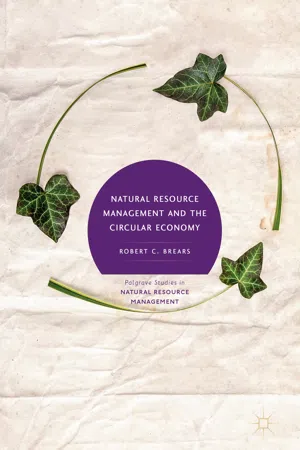In our current economic
model, manufactured capital, human capital, and natural
capital all contribute to human welfare by supporting the production of goods and services in the economic process, where
natural capital —the world’s stock of natural resources (provided by nature before their extraction or processing by humans)—is typically used for material and energy inputs into production and acts as a ‘sink’ for waste from the economic process.
2 This economic model can be best described as ‘linear’ which typically involves economic actors
3—who are people or organisations engaged in any of the four economic activities of production, distribution, consumption, and resource maintenance—harvesting and extracting natural resources, using them to manufacture a product, and selling a product to other economic actors, who then discard it when it no longer serves its purpose.
4 As such, natural resources in the linear economic model:
Become inputs: Material resources used in the economy come from raw materials that are extracted from domestic natural resource stocks or extracted from natural resource stocks abroad and imported in the form of raw materials, semi-finished materials, or materials embedded in manufactured goods. Material resources are extracted with the usable parts of the resources entering the economy as material inputs where they become priced goods that are traded, processed, and used. Other parts remain unused in the environment and are called unused materials or unused extraction.
Become outputs: After use in production and consumption activities, materials leave the economy as an output either to the environment in the form of residuals (pollution, waste) or in the form of raw materials, semi-finished materials, and materials embedded in manufactured goods.
Accumulate in man-made stocks: Some materials accumulate in the economy where they are stored in the form of buildings, transport infrastructure, or durable and semi-durable goods such as cars, industrial machinery, and household appliances. These materials are eventually released in the form of demolition waste, end-of-life vehicles, e-waste, bulky household waste, and so on, which if not recovered flow back to the environment.
Create indirect flows: When materials or goods are imported for use in an economy, their upstream production is associated with unused materials that remain abroad including raw materials needed to produce the goods and the generation of residuals. These indirect flows of materials consider the life cycle dimension of the production chain but are not physically imported. As such, the environmental consequences occur in countries from which the imports originate5
Linear Economy Challenges
While the current linear economic model has generated an unprecedented level of growth, the model has led to constraints on the availability of natural resources due to rising demand, in addition to the generation of waste and environmental degradation from a variety of challenges.
Economic Growth
The world economy is projected to grow on average by just over 3 percent per annum over the period 2014–2050, resulting in the global economy doubling in size by 2037 and nearly tripling by 2050. During this time, there will be a shift in economic power away from the established advanced economies in North America, Europe, and Japan towards the emerging economies. For example, rapid economic growth in Mexico and Indonesia could result in these countries having larger economies than the UK and France by 2030, in purchasing power parity terms, while other economies including Nigeria and Vietnam could grow at 5 percent or more per annum by 2050 compared to projected growth of 1.5–2.5 percent in advanced economies.6 To date, rising global consumption and the industrialisation of developing countries, in addition to globalisation, has led to the rapid increase in global trade with the physical trade volume more than doubling in total between 1980 and 2010. While there was a slowdown in trade in the early 1980s due to the second oil crisis and in 2009 from the global financial crisis, the physical trade volume between these periods increased on average by 2.4 percent per annum.7 It is estimated that if the global economy carries on in a business-as-usual manner regarding resource consumption , we will need by 2050, on aggregate, the equivalent of two planets to sustain us.8
Changing Consumption Patterns
As income levels rise, changes in spending patterns occur when individuals move from a very low income (annual wages of less than USD $1000 per annum) to a lower middle income (between USD $3000 and USD $5000). For instance, as income levels rise, individual spending on food falls from more than 40 percent of the total income to around 10 percent. Regarding expenditure on types of foods, there is a strong positive correlation between the level of income and the consumption of animal protein with the consumption of meat, milk, and eggs increasing at the expense of staple foods.9 Meanwhile, demand for clothing increases significantly as income rises, with emerging markets projected to make up 57 percent of total global clothing demand in 2050, up from 35 percent in 2012. Housing and furniture demand will increase with rising income levels too: In China, refrigerator ownership per 100 rural households increased from 0.1 to 17.8 between 1980 and 2004.10 Demand for smartphones, tablets, and LCD/LED TVs will result in revenues for the consumer electronics market reaching nearly USD $3 trillion in 2020, up from around USD $1.45 trillion in 2015, with rising disposable income among the middle class in China and India expected to contribute significantly to this demand.11
Raw Material Scarcity
With rising income levels and economic growth around the world, raw material extraction is increasing to meet demand for both high-tech products and everyda...
